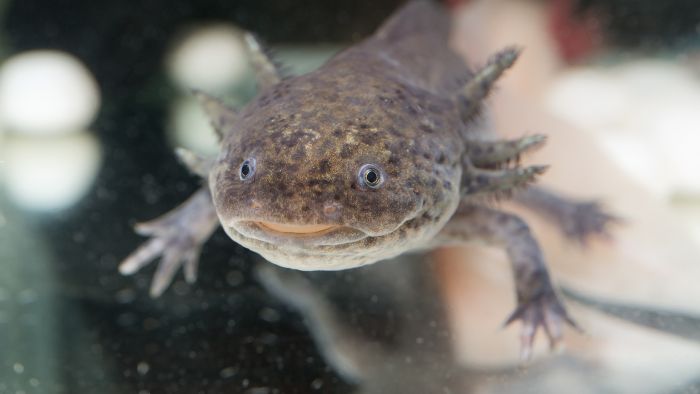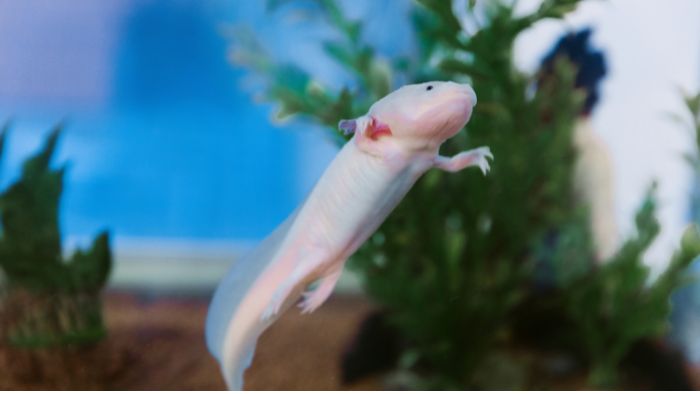Last Updated on July 31, 2022 by admins
Can axolotls change color? Keep reading and find out one of the biggest mysteries ever.
Did you know that the Aztecs, when they settled in the valley of Mexico in the 13th century, found a large salamander in the lake around which they built their ancient city of Tenochtitlán? This salamander was then named “axolotl” after Xolotl, the god of fire and lightning. According to their belief, this god was transformed into a salamander to avoid sacrifice so that the sun and moon could move in the sky. Unfortunately, he was eventually caught and then killed.
Axolotls are cute, charismatic salamanders known for their incredible power to regenerate body parts. Besides that, there is a very interesting question “can axolotls change color?” If you are curious and want to know the answer to this question, but also many other fun facts about this unique, aquatic creature, stay with us and find out.
A Few Words About This Beautiful Animal Species
Before you find out the correct answer to the question “can axolotls change color”, let us introduce you to this beauty. As we have already mentioned, Axolotl (Ambystoma mexicanum) is a species of salamander belonging to the family Ambystomatidae (order Caudata). It is one of those creatures known for its permanent retention of larval features. We must note that this salamander is classified as a critically endangered species due to pollution and urbanization. Furthermore, this name also applies to all adult larvae of Ambystoma tigrinum that haven’t yet managed to lose their external gills.
They usually grow about 10 inches, and when it comes to the color they are most often brown with black spots, but there are also albino and white mutants. They have small legs and feet and a long tail, their fins extend from the back of the head all the way to the tip of the tail.
In terms of diet, they prey on a variety of aquatic organisms, including fish, mollusks, aquatic insects, and in some cases even other members of their species. Their lifespan is much shorter when they grow in the wild, only five or six years, as opposed to growing in captivity where they can live up to 15 years.
Their population has declined drastically in recent decades thanks to a combination of habitat loss, water pollution, and invasive species. Did you know that ecologists believe that there are currently less than 1,000 axolotls in the wild? That’s a pretty sad realization. Prompted by this, the International Union for the Conservation of Nature and Natural Resources (IUCN) has listed them among the most endangered species in the world.
Now that you are more familiar with this beautiful aquatic creature, it is time to move on to the main part of this article and finally to find out whether can axolotls change color. So let’s get to the point.
Can Axolotls Change Color?
As for colors, these beauties can appear in the wild, leucistic, white albino, golden and melanoid, with leucistic usually referred to as “lucy”, brown (wild), yellow, cyan, and blue.
So, can axolotls change color? – In short, yes! This usually happens due to increased blood flow in their body, and therefore adults can change color. In addition, we must not forget to mention that some species that grow in the wild darken over time, and eventually end up in dark black which is actually the complete opposite of their original color.
This phenomenon mainly occurs for several reasons, most often in order to adapt to the environment that surrounds them and thus protect them from potential predators. In addition, they change color if they are exposed to large amounts of stress or are injured and lose blood.
Keep in mind that natural lighting also plays a big role in making these aquatic creatures seem to change color. Furthermore, during high activity, there is an increased blood flow which makes their color look brighter and the gills more colorful. During reduced activity levels, axolotls usually look quite pale, especially around the gill area.
In Conclusion
We hope you have learned a lot of new information about axolotls and their characteristic colors. So, let’s repeat some of the most important facts. When grown in the wild they usually have earthy tones like black, brown, and olive, and they can indeed change color in several situations, usually when resting or if they are injured or exposed to great stress.
Did you know the correct answer to the question “can axolotls change color”? Let us know in the section below.
FAQ’s
What Is The Rarest Color Of Axolotl?
The rarest color of axolotl in real life is firefly. This beautiful color is dark (just like the salamander that lives in the wild), but there are some differences, namely firefly axolotl has a fluorescent green tail that glows in the dark.
In addition, there are some rare colors, but they are so rare that it is almost impossible to obtain, that is, an enigma, chimera, and mosaic colors.
Do Axolotls Change Color With Age?
In addition to being unpredictable and beautiful in every aspect, axolotls can change their color as they age. Some species slowly change their characteristic color to black or white.
Do Axolotls Change Color When Stressed?
Axolotls can have changes in pigmentation and become lighter or darker, depending on the color of the environment in which they are located. This type of change usually occurs when resting, but can also be considered a sign of stress or blood loss if they are seriously injured.
Which Axolotl Is The Rarest?
The rarest species of the axolotl is the enigma morph. It was originally developed by an American breeder and almost everything related to this beauty is a real unknown. They are best known because they change color as well as the pattern as they age.
When they are still young, Enigma morphs have a very solid black color that changes to a yellowish-green. Then, as they get older, they develop more and more green spots and eventually become full of green and yellow spots. However, one thing almost never changes, and they in most cases retain their well-known pink gills.

